The Papal Basilica of St. Peter (Latin: Basilica Sancti Petri; Italian: Basilica Papale di San Pietro in Vaticano), or simply St. Peter’s Basilica, the most prominent building in the Vatican City, is regarded as one of the holiest Catholic shrines and the most renowned work of Italian Renaissance architecture. As a work of architecture, it is regarded as the greatest building of its age. Located west of the River Tiber, near the Janiculum Hill and Hadrian’s Mausoleum, its central dome Its dome is a dominant feature of the skyline of Rome. Best appreciated from a distance, the basilica is approached via St. Peter’s Square.
The basilica has the following specifications:
- Area: 2.3 hectares (5.7 acres)
- Cost of construction of the basilica: more than 46,800,052 ducats
- Geographic orientation: chancel west, nave east
- Total length: 730 ft. (220 m.)
- Total width: 500 ft. (150 m.)
- Interior length including vestibule: 693.8 ft. (211.5 m.), more than ⅛ mile.
- Length of the transepts in interior: 451 ft. (137 m.)
- Width of nave: 90.2 ft. (27.5 m.)
- Width at the tribune: 78.7 ft. (24 m.)
- Internal width at transepts: 451 ft. (137 m.)
- Internal height of nave: 151.5 ft. (46.2 m.) high
- Total area: 227,070 sq. ft. (21,095 m2), more than 5 acres (20,000 m2).
- Internal area: 163,182.2 sq. ft. (3.75 acres; 15,160.12 m2)
- Height from pavement to top of cross: 448.1 ft. (136.6 m.)
- Façade: 167 ft. (51 m.) high by 375 ft. (114 m.) wide
- Vestibule: 232.9 ft. (71 m.) wide, 44.2 ft. (13.5 m.) deep, and 91.8 ft. (28 m.) high
- The internal columns and pilasters: 92 ft. (28 m.) tall
- The circumference of the central piers: 240 ft. (73 m.)
- Outer diameter of dome: 137.7 ft. (42.0 m.)
- The drum of the dome: 630 ft. (190 m) in circumference and 65.6 ft. (20.0 m) high, rising to 240 ft. (73 m) from the ground
- The lantern: 63 ft. (19 m.) high
- The ball and cross: 8 and 16 ft. (2.4 and 4.9 m.), respectively
- Peter’s Square: 1,115 ft. (340 m.) long, 787.3 ft. (240 m.) wide
- Each arm of the colonnade: 306 ft. (93 m.) long, and 64 ft. (20 m.) high
- The colonnades have 284 columns, 88 pilasters, and 140 statues
- Obelisk: 83.6 ft. (25.5 m.). Total height with base and cross, 132 ft. (40 m.).
- Weight of obelisk: 360.2 short tons (326,800 kgs.; 720,400 lbs.)
Here are some interesting trivia regarding St. Peter’s Basilica:
- It is probably the largest church in Christendom.
- The dome, rising to a total height of 136.57 m. (448.1 ft.) from the floor of the basilica to the top of the external cross, is the tallest dome in the world.Its 41.47 m. (136.1 ft.) internal diameter, greater in diameter by approximately 30 ft. (9.1 m.) than Constantinople’s Hagia Sophia church (completed in 537), is slightly smaller than two of the three other huge domes that preceded it – the 3 m. (142 ft.) of the Pantheon of Ancient Rome and the 44 m. (144 ft.) of the Early Renaissance Florence Cathedral. Conceived, from the outset, as the greatest dome of Christendom, the architects of St. Peter’s looked for solutions as to how to go about building the dome from the domes of the Pantheon and Florence Duomo.
- While it is neither the Pope‘s official seat, mother church (this honor is held by the Pope’s cathedral, the Archbasilica of St. John Lateran) of the Catholic Church or the cathedral of the Diocese of Rome, St. Peter’s is certainly the Pope’s principal church in terms of use because most Papal liturgies and ceremonies take place there due to its size, proximity to the Papal residence, and location within the Vatican City proper. The Pope presides at a number of liturgies throughout the year, drawing audiences of 15,000 to over 80,000 people, either within the Basilica or the adjoining Peter’s Square.
- One of the holiest sites of Christianity, Catholic tradition holds that the Basilica is traditionally the burial site of its titular, Peter, head of the twelve Apostles of Jesus and, according to tradition, the first Bishop of Antioch and later the first Bishop of Rome, rendering him the first Pope Supposedly, St. Peter’s tomb is directly below below the baldachin and high altar of the Basilica in the “Confession.”
- Peter’s, one of the Papal Basilicas (previously styled “patriarchal basilicas”), is one of the four churches of Rome that hold the rank of Major Basilica (all of which are also Papal Basilicas), the others being the Basilicas of St. John Lateran, St. Mary Major, and St. Paul outside the Walls. However, unlike all the other Papal Major Basilicas, it is wholly within the territory, and thus the sovereign jurisdiction, of the Vatican City State, and not that of Italy.
- Contrary to popular misconception, it is not a cathedral because it is not the seat of a bishop. The Cathedra of the Pope, as Bishop of Rome, is in the Archbasilica of St. John Lateran.
- Within St. Peter’s Basilica are over 100 tombs (extant to various extents), many located in the Vatican grotto, of 91 popes (the most recent interment was Pope John Paul II, on April 8, 2005), since the Early Christian period, in the necropolis beneath the basilica. Many of the tombs of popes are considered outstanding artworks. Other notable people are also buried here. They include, St. Ignatius of Antioch; Holy Roman Emperor Otto II; the composer Giovanni Pierluigi da Palestrina; exiled Catholic British royalty James Francis Edward Stuart and his two sons, Charles Edward Stuart and Henry Benedict Stuart; Cardinal Bishop of Frascati (having been granted asylum by Pope Clement XI); Maria Clementina Sobieska (wife of James Francis Edward Stuart); Queen Christina of Sweden (who abdicated her throne in order to convert to Catholicism); and Countess Matilda of Tuscany (supporter of the Papacy during the Investiture Controversy). Beneath, near the crypt, is the recently discovered vaulted 4th-century “Tomb of the Julii.”
- The “Chair of Saint Peter” (cathedra), an ancient chair sometimes presumed to have been used by St. Peter himself and used by many popes, was actually a 12th century gift from Charles the Bald.
Designed principally by Donato Bramante, Michelangelo, Carlo Maderno and Gian Lorenzo Bernini, the façade of the basilica, designed by Maderno, is 114.69 m. (376.3 ft.) wide and 45.55 m. (149.4 ft.) high and is built of travertine stone, with a giant order of Corinthian pilasters, all set at slightly different angles to each other (in keeping with the ever-changing angles of the wall’s surface), and a central pediment rising in front of a tall attic surmounted by 13 statues: Christ flanked by 11 of the Apostles (except St. Peter, whose statue is left of the stairs) and John the Baptist.

The inscription below the cornice on the 1 m. (3.3 ft.) tall frieze reads: IN HONOREM PRINCIPIS APOST PAVLVS V BVRGHESIVS ROMANVS PONT MAX AN MDCXII PONT VII In honour of the Prince of Apostles, Paul V Borghese, a Roman, Supreme Pontiff, in the year 1612, the seventh of his pontificate)
The huge cornice, above them, ripples in a continuous band, giving the appearance of keeping the whole building in a state of compression. The facade stretches across the end of the square and is approached by steps on which stand two 5.55 m. (18.2 ft.) statues of Saints Peter and Paul, the 1st-century apostles to Rome. Construction of the current basilica, replacing the Old St. Peter’s Basilica begun by the Emperor Constantine the Great (between 319 and 333 AD), was started on April 18, 1506 by Pope Julius II. In the next 120 years, after a succession of popes and architects, it was solemnly dedicated by Pope Urban VIII on November 18, 1626.
Cruciform in shape, the basilica has an elongated nave in the Latin cross form with a central space dominated, both externally and internally, by one of the largest domes in the world. In the towers to either side of the facade are two clocks, designed by Giuseppe Valadier from 1786-1790. The one on the right, called the Oltramontano Clock, has one hand showing European mean time. The one on the left, called the Italian Clock, shows Rome time. The oldest bell of the clock on the left, operated electrically since 1931, dates from 1288.
Behind the façade of St. Peter’s, stretching across the building, is a narthex (long portico or entrance hall) such as was occasionally found in Italian Romanesque churches. Part of Maderno’s design, it has a long barrel vault decorated with ornate stucco and gilt and successfully illuminated by small windows between pendentives. Its ornate marble floor is beamed with light reflected in from the piazza
A mosaic, one of the most important treasures of the basilica, is set above the central external door. Called the “Navicella,” it is mostly a 17th-century copy of Giotto‘s early 14th century and it represents a ship symbolizing the Christian Church. At each end of the narthex is a theatrical space framed by Ionic columns. Within each is set a equestrian statue – an 18th century equestrian figure of Charlemagne by Cornacchini in the south end and Constantine the Great by Bernini (1670) in the north end.
Of the five portals (three framed by huge salvaged antique columns)from the narthex to the interior, three contain notable doors. The Renaissance bronze door (called Filarete), the central portal created by Antonio Averulino in 1455 for the old basilica, was somewhat enlarged to fit the new space. The “Door of the Dead,” the southern door, was designed by 20th-century sculptor Giacomo Manzù and includes a portrait of Pope John XXIII kneeling before the crucified figure of St. Peter. The “Holy Door,” the decorated northernmost bronze doors leading from the narthex is, by tradition, walled-up with bricks and opened only for holy years such as the Jubilee year by the Pope. The present door is bronze and was designed by Vico Consorti in 1950 and cast in Florence by the Ferdinando Marinelli Artistic Foundry. Above it are inscriptions commemorating the opening of the door.
The design of St. Peter’s Basilica and, in particular, its dome, has greatly influenced church architecture in Western Christendom. They include:
- Sant’Andrea della Valle (Rome) – designed by Giacomo della Porta before the completion of St Peter’s Basilica, and subsequently worked on by Carlo Maderno.
- San Carlo ai Catinari
- Sant’Agnese in Agone
- St Paul’s Cathedral(London, England) – designed by Christopher Wren
- Karlskirche(Vienna, Austria)
- Nicholas Church(Prague, Czech Republic)
- Pantheon(Paris, France)
Elements of St Peter’s Basilica’s were imitated, to a greater or lesser degree, by a great number of churches built during 19th and early-20th-century Post-Modernism architectural revivals. They include:
- Mary of the Angels in Chicago
- Josaphat’s Basilicain Milwaukee
- Immaculate Heart of Mary in Pittsburgh
- Mary, Queen of the World Cathedralin Montreal
- Basilica of Our Lady of Licheń
- Basilica of Our Lady of Peace of Yamoussoukro.
Compared with other churches, its entire, “stupendously large” interior, lavishly decorated with marble, reliefs, architectural sculpture and gilding, has vast dimensions so much so that it is hard to get a sense of scale within the building. The nave, framed by wide aisles (which have a number of chapels off them), lead to the central dome and is in three bays, with piers supporting a barrel vault, the highest of any church. In keeping with Michelangelo’s work, it has huge paired pilasters.
The aisles each have two smaller chapels and a larger rectangular chapel, the Chapel of the Sacrament and the Choir Chapel. Though lavishly decorated with marble, gilt, sculpture, stucco and mosaic they, remarkably, have very few paintings, although some, such as Raphael’s “Sistine Madonna” have been reproduced in mosaic. A small icon of the Madonna, removed from the old basilica, is the most precious painting.
The sanctuary culminates in a sculptural ensemble, also by Bernini, and contains the so-called “Chair of Saint Peter” (Cathedra Petri ), a large bronze throne in the apse enshrined, with great celebration, in its new home on January 16, 1666. Symbolizing the continuing line of apostolic succession from St. Peter to the reigning Pope, the chair is raised high on 4 looping supports held effortlessly by massive and dynamic bronze statues, with sweeping robes and expressions of adoration and ecstasy, of the four Doctors of the Church – Saints Ambrose and Augustine, representing the Latin Church, and Athanasius and John Chrysostom, the Greek Church. A window of yellow alabaster, behind and above the Cathedra, illuminates, with a blaze of light, the Dove of the Holy Spirit at its center.
The Nave
- Two holy water basins, fluttering against the first piers of the nave, are held by four cherubs, each commissioned by Pope Benedict XIII from designer Agostino Cornacchini and sculptor Francesco Moderati, (1720s). They appear of quite normal cherubic size but, once approached, it becomes apparent that each one is over 2 m. high and that real children cannot reach the basins unless they scramble up the marble draperies.
- Markers, showing the comparative lengths of other churches, starting from the entrance, are found along the floor of the nave.
- Medallions, with relief depicting the first 38 popes, are on the decorative pilasters of the piers of the nave.
- Statues, depicting 39 founders of religious orders, are in niches between the pilasters of the nave.
- A statue of St. Peter Enthroned, set against the north east pier of the dome, is sometimes attributed to late 13th-century sculptor Arnolfo di Cambio (some scholars dating it to the 5th century). One foot of the statue is largely worn away by pilgrims kissing it for centuries.
- The sunken, crypt-like Confessio or “Chapel of the Confession” (in reference to the confession of faith by St. Peter, which led to his martyrdom), leading to the Vatican Grottoes, is located at the heart of the basilica, beneath the dome and high altar. Maderno’s last work, it contains a large kneeling statue, by Canova, of Pope Pius VI, who was captured and mistreated by the army of Napoleon Bonaparte. Two curving marble staircases, remnants of the old basilica, lead to this underground chapel at the level of the Constantinian church and immediately above the purported burial place of Saint Peter. Here, cardinals and other privileged persons could descend in order to be nearer to the burial place of the apostle. Around its balustrade are 95 bronze lamps.
- The Niche of the Pallium (“Niche of Stoles”), in the Confessio, contains a bronze urn, donated by Pope Benedict XIV, to contain white stoles embroidered with black crosses and woven with the wool of lambs blessed on St. Agnes’ Day.
- The High Altar, surmounted by a baldachin (baldacchino), its central feature, was the first work designed by Gian Lorenzo Bernini at St. Peter’s. This 30 m. (98 ft.) high, pavilion-like structure, claimed to be the largest piece of bronze in the world, stands beneath the dome and above the Papal Its design, based on the ciborium (of which there are many in the churches of Rome), serves to create a sort of holy space above and around the table on which the Sacrament is laid for the Eucharist and emphasizing the significance of this ritual.
- As part of the scheme for the central space of the church, Bernini had the piers, , hollowed out into niches, and had staircases made inside them, leading to four balconies. On the balconies Bernini created showcases, framed by the eight ancient twisted columns, to display the four most precious relics of the basilica. Set in each of the niches, within the four huge piers (begun by Bramante and completed by Michelangelo) supporting the dome, are the huge statues of the saint associated with the basilica’s primary holy relics – Saint Helena, Constantine’s mother, holding the True Cross and the Holy Nails (by Andrea Bolgi); Saint Longinus holding the spear that pierced the side of Jesus (by Bernini, 1639); Saint Andrew, the brother of St. Peter, with the Andrew’s Cross (by Francois Duquesnoy) and Saint Veronica holding her miraculous veil with the image of Jesus’ face (by Francesco Mochi).
North Aisle
- Michelangelo‘s Pietà is in the first chapel of the north aisle.
- The monument of Queen Christina of Sweden, who abdicated in 1654 in order to convert to Catholicism, is on the first pier in the right aisle.
- The second chapel, dedicated to Sebastian, contains the statues of popes Pius XI and Pius XII. The space below the altar, housing the remains of Pope John Paul II (placed here on May 2, 2011), used to be the resting place of Pope Innocent XI whose remains were moved to the Altar of the Transfiguration on April 8, 2011.
- The Chapel of the Blessed Sacrament, the large chapel on the right aisle, contains the tabernacle by Bernini (1664). Resembling Bramante‘s Tempietto at San Pietro in Montorio, it is supported by two kneeling angels and, behind it, is a painting of the Holy Trinity by Pietro da Cortona.
- The monuments of popes Gregory XIII by Camillo Rusconi (1723) and Gregory XIV are near the Altar of Our Lady of Succor.
- An altar containing the relics of Petronilla, with an altarpiece “The Burial of St Petronilla by Guercino (Giovanni Francesco Barbieri), 1623, is at the end of the aisle.
South Aisle
- The baptistery, the first chapel in the south aisle, was commissioned by Pope Innocent XII and designed by Carlo Fontana, (great nephew of Domenico Fontana). The font, previously located in the opposite chapel, is the red porphyry sarcophagus of Probus, the 4th-century Prefect of Rome. The lid came from a sarcophagus which had once held the remains of the Emperor Hadrian. Previously stored in the Vatican Grotto, workmen broke it into ten pieces during removal and Fontana restored it expertly and surmounted it with a gilt-bronze figure of the “Lamb of God.”
- The Monument to the Royal Stuarts, set against the first pier of the aisle, is a Neo-Classical tomb (designed by Canova and unveiled in 1819) for James and his sons, Charles Edward (known as “Bonnie Prince Charlie”) and Henry, Cardinal and Duke of York. Opposite it is the memorial to Maria Clementina Sobieska, James Francis Edward Stuart’s wife.
- The second chapel, that of the Presentation of the Virgin, contains the memorials of Pope Benedict XV and Pope John XXIII.
- The tombs of Pope Pius X and Pope Innocent VIII are set against the piers.
- The Choir Chapel, the large chapel off the south aisle, contains the Altar of the Immaculate Conception.
- The tomb of Pope Pius VIII is at the entrance to the Sacristy.
- The altars of Saint Thomas, Saint Joseph and the Crucifixion of Saint Peter are at the south transept.
- Towards the end of the aisle is the tomb of Fabio Chigi, Pope Alexander VII. The work of Bernini and called by Lees-Milne “as one of the greatest tombs of the Baroque Age,” it is awkwardly set in a niche above a doorway, utilized by Bernini in a symbolic manner, into a small vestry. Pope Alexander, facing outward, kneels upon his tomb. The tomb, supported on a large draped shroud in patterned red marble, is supported by four female figures, of whom only the two at the front, representing Charity and Truth, are fully visible. The foot of Truth rests upon a globe of the world, her toe being pierced symbolically by the thorn of Protestant England. The skeletal winged figure of Death, coming forth, seemingly, from the doorway as if it were the entrance to a tomb, has its head hidden beneath the shroud, but its right hand carries an hour glass stretched upward towards the kneeling figure of the pope.
- The white marble Monument to Leo XI, by Alessandro Algardi (1595-1654), has roses carved on the plinth and the inscription “Sic florui”, refer to the fact that he reigned only 27 days, in 1605. Beside him are two female allegories: Fortitude and Generosity.
- The Monument of Pius VII, occupying part of the left wall of the Clementine Chapel, is the work of the Danish sculptor, Bertel Thorvaldsen (1770-1844).Two winged cupids, one symbolizing time (hourglass) and the other history (book), are located on the sides of the throne. The two statues of “Knowledge” and “Fortitude,” on high pedestals, are located on the sides of the Doric door. The first is depicted in a meditative pose, with the Bible open and, at its feet, an owl, the symbol of prudence. The second figure is dressed in lion skins, while one foot stands on a club.
- Passing from the transept to the left aisle, on the left is the Altar of the Lie or the Altar of Ananias and Sapphira. Its mosaic, after a painting by Cristoforo Roncalli (known as Pomarancio, 552-1626), shows the punishment of the couple who had lied to St. Peter about the price of a field sold by them, and were therefore immediately struck dead.
St. Peter’s Basilica: Piazza San Pietro, 00120 Città del Vaticano, Vatican City. Open daily, April -September, 7 AM -7 PM; October – March, 7 AM – 6 PM.
How to Get There:
By Subway – Take Linea A (red line) toward Battistini and exit at Ottaviano-S. Pietro. Walk south on Via Ottaviano toward St. Peter’s Square.
By Walking – From the city center, the most direct route is to cross the Tiber and walk straight up Via Conciliazioni. A more interesting route is to go under the Passetto arch near Castel S. Angelo and walk up Pio Borgo, providing a more dramatic entrance from the right (north) side of the Piazza.

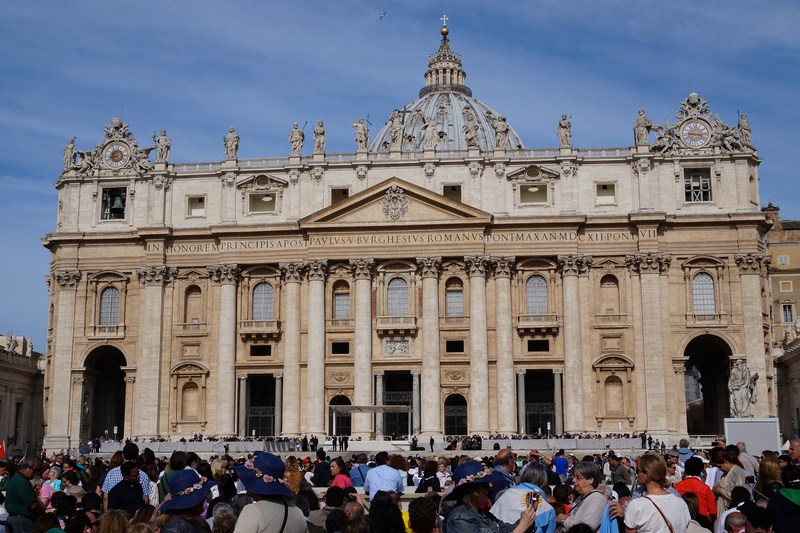
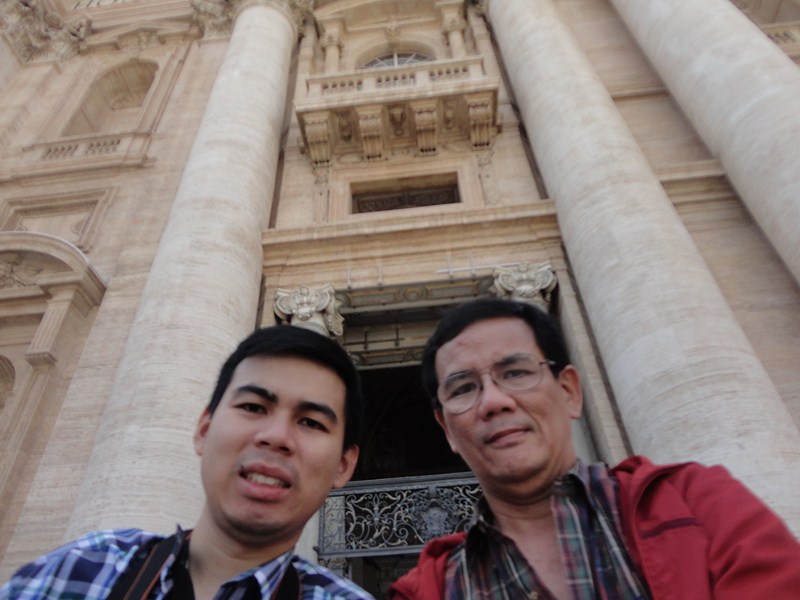
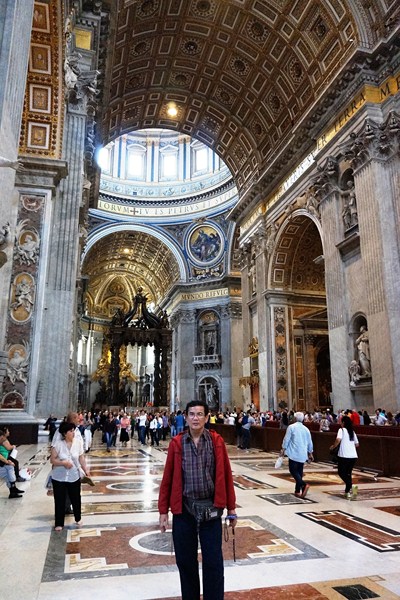
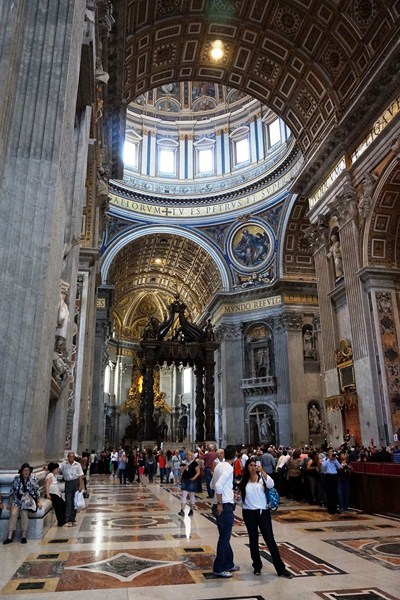
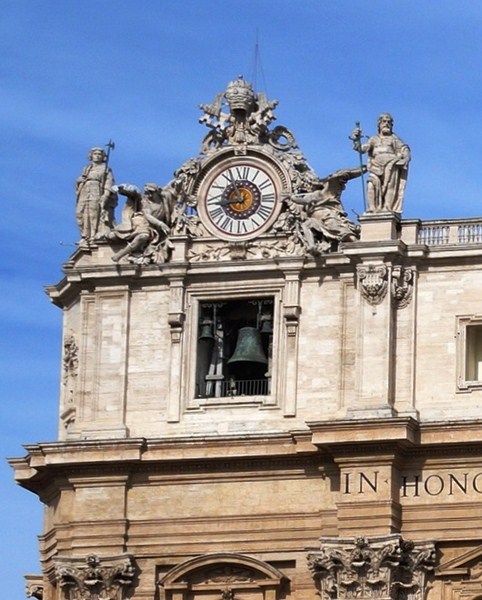
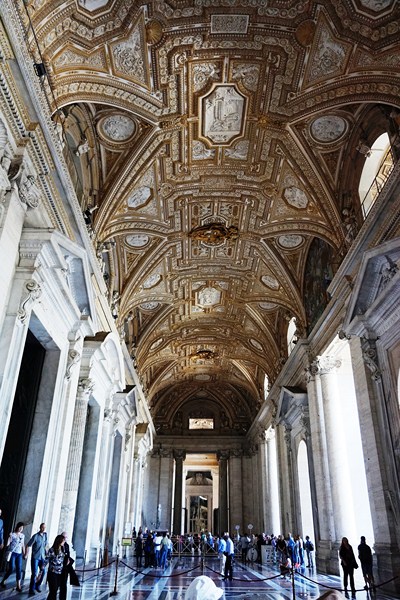
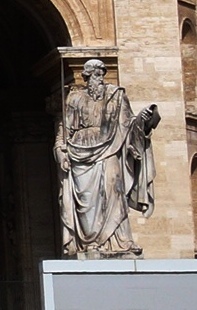

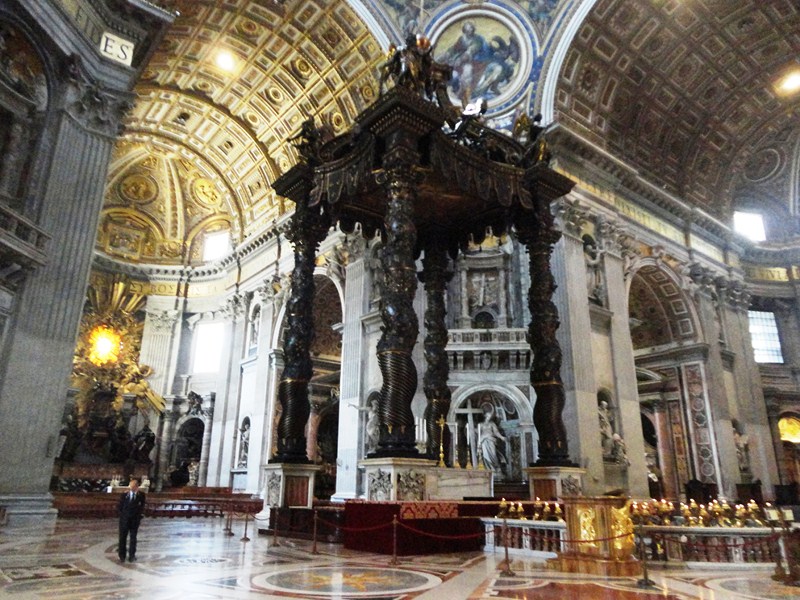
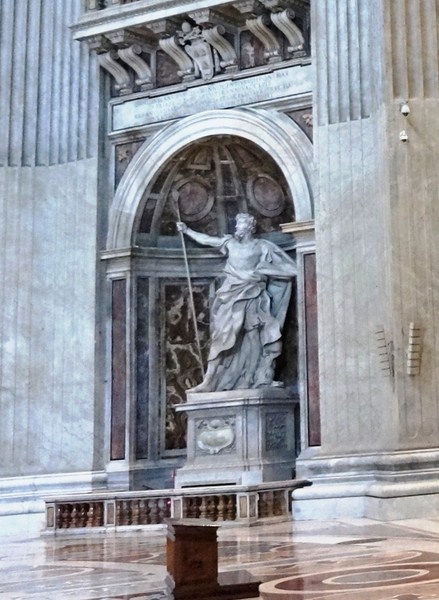
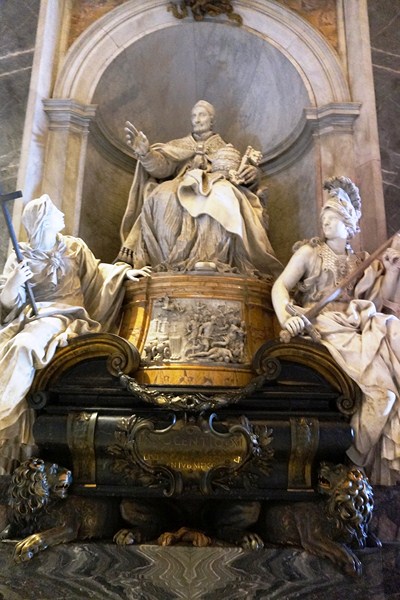
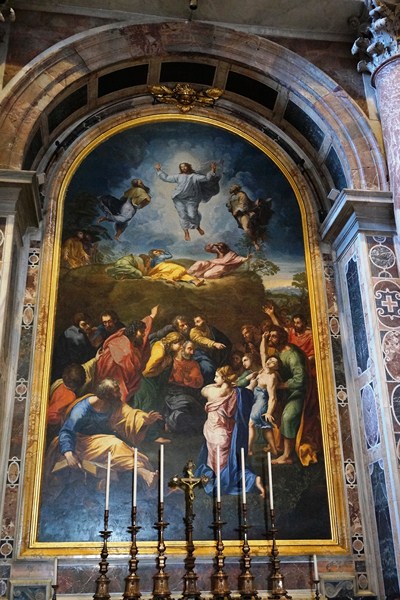
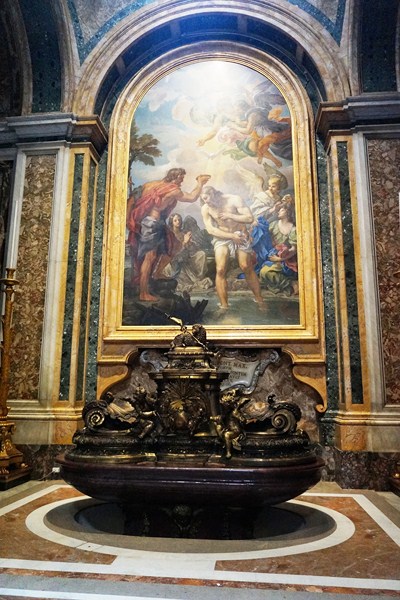
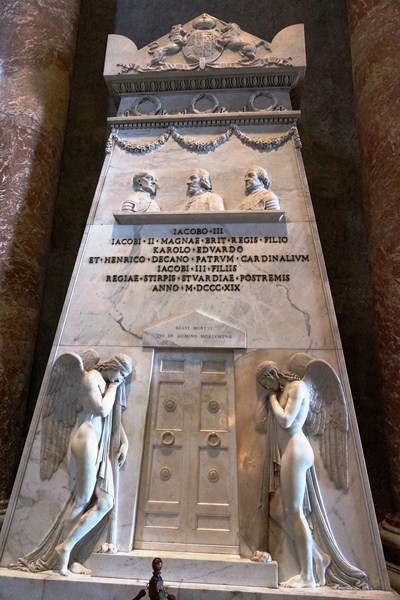
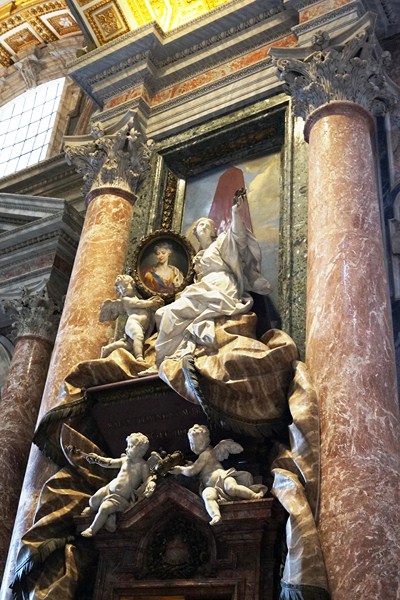
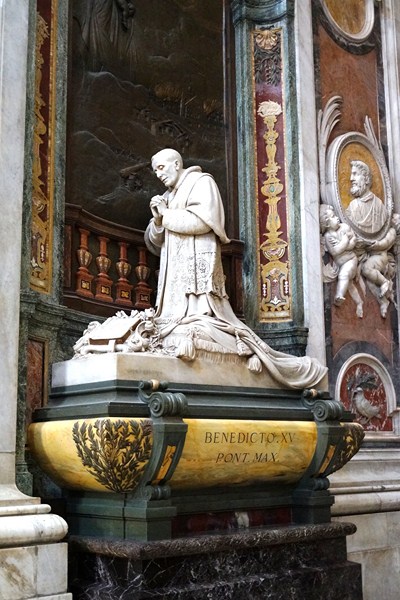
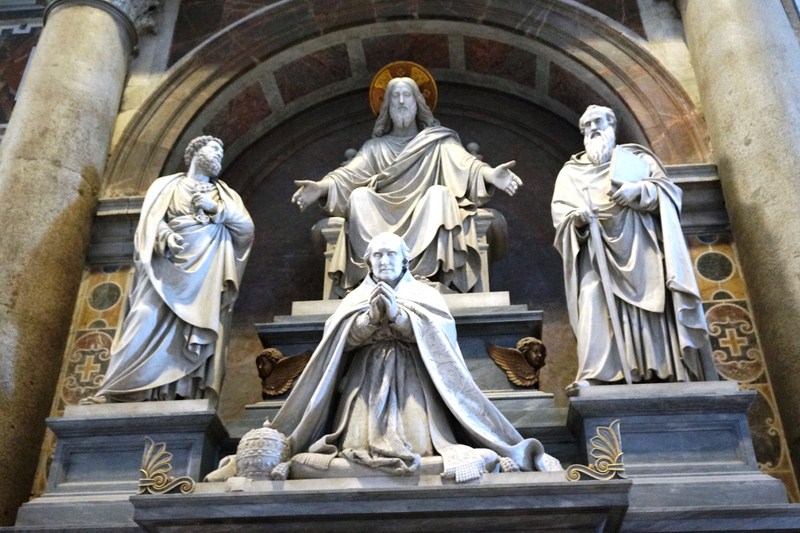
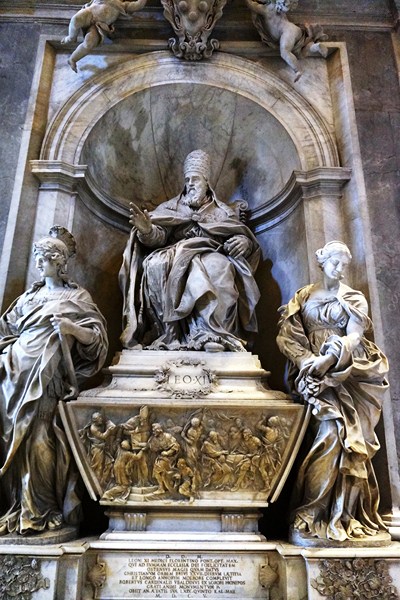
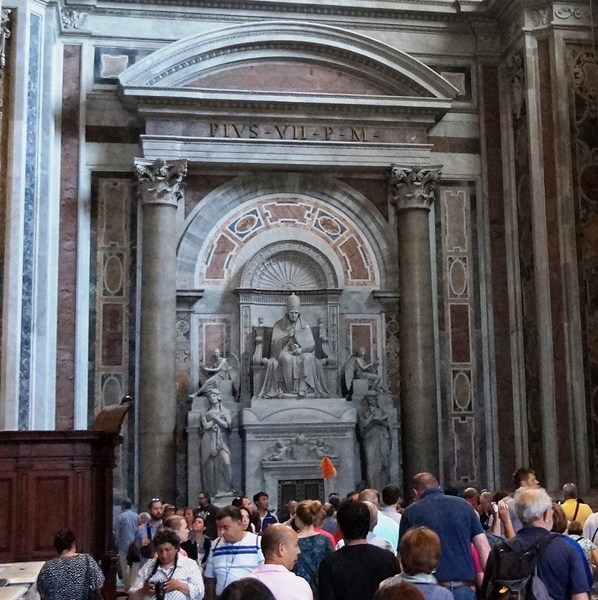
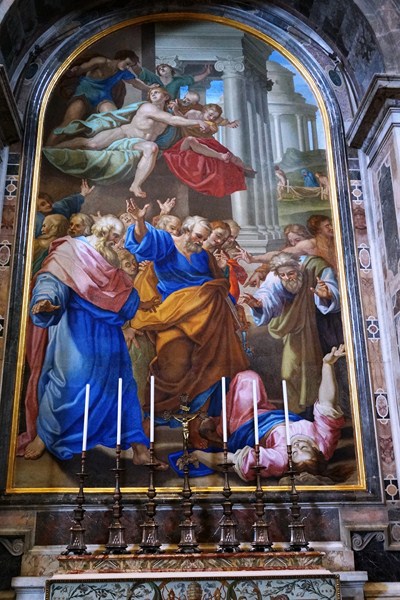
Przyjazń to milczaca nieformalna umowa miedzy dwiema osobami odznaczajacymi sie instynktem spolecznym i zaletami serca. F. Arouet Czy wiesz jaki jest Socjologiczny aspekt tej sentencji ?